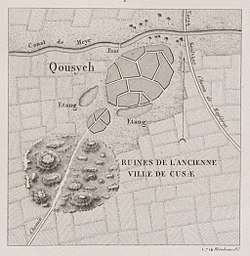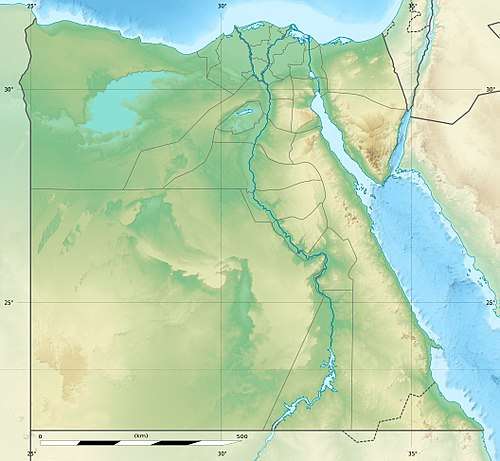Cusae
Cusae (Ancient Greek: Κοῦσαι or Κῶς; Coptic: ⲕⲱⲥⲉⲓ or ⲕⲟⲥⲉⲓ)[2] was a city in Upper Egypt, known to the Ancient Egyptians as Qis or Kis. Today, the town is known as El Quseyya, and is located on the west bank of the Nile in the Asyut Governorate.
Cusae القوصية | |
|---|---|
City | |
 Old map of Cusae from Description de l'Égypte | |
 Cusae Old map of Cusae from Description de l'Égypte | |
| Coordinates: 27°26′40″N 30°49′00″E | |
| Country | |
| Time zone | UTC+2 (EST) |
| ḳsj[1][2] in hieroglyphs |
|---|
At the beginning of the reign of the Theban pharaoh Kamose, Cusae marked the boundary between the northern Hyksos realm (the 15th Dynasty) and the southern Theban kingdom (the 17th Dynasty).[3] It was a cult centre for Hathor, and also contained a necropolis, Meir, which was used during the Middle Kingdom to hold the tombs of local aristocrats.
During the 5th century, the city was the settlement of Legio II Flavia Constantia.
Bishopric
The bishopric of Cusae was a suffragan of the metropolitan see of Antinoë, capital of the Roman province of Thebaid I. Achilles (or Achilleus) was ordained bishop of the see by Meletius of Lycopolis. Another, Elias, was of the 4th or 5th centuries.[4] Theonas took part in the Second Council of Constantinople (553). Later bishops took the non-Chalcedonian side, the first of them being Gregorius, who assisted Pope John II (III) of Alexandria on his deathbed.[5][6][7][8]
No longer a residential bishopric, Cusae is today listed by the Catholic Church as a titular see.[9]
References
- Wallis Budge, E. A. (1920). An Egyptian hieroglyphic dictionary: with an index of English words, king list and geological list with indexes, list of hieroglyphic characters, coptic and semitic alphabets, etc. Vol II. John Murray. p. 1044.
- Gauthier, Henri (1928). Dictionnaire des Noms Géographiques Contenus dans les Textes Hiéroglyphiques Vol. 5. pp. 164, 165.
- Grimal, Nicolas (1992). A History of Ancient Egypt. Oxford: Blackwell Books. p. 191.
- S. Timm, Das christlich-koptische Ägypten, Wiesbaden 1982-1992, 2181 e 2189 n. 4.
- Michel Lequien, Oriens christianus in quatuor Patriarchatus digestus, Paris 1740, Vol. II, coll. 595-598
- Raymond Janin, v. Cusae in Dictionnaire d'Histoire et de Géographie ecclésiastiques, vol. XIII, Paris 1956, col. 1117
- Klaas A. Worp, A Checklist of Bishops in Byzantine Egypt (A.D. 325 - c. 750), Zeitschrift für Papyrologie und Epigraphik 100 (1994) 283-318
- Sophrone Pétridès, "Cusae" in Catholic Encyclopedia (New York 1908)
- Annuario Pontificio 2013 (Libreria Editrice Vaticana 2013 ISBN 978-88-209-9070-1), p. 878